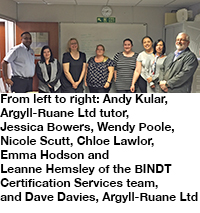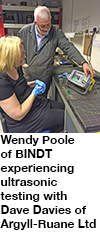BINDT’s Certification Services Division praises NDT Appreciation course
23/06/2015
 The British Institute of Non-Destructive Testing (BINDT) is keen that industry understands the benefits of NDT, condition monitoring (CM) and all other materials testing disciplines and works to actively promote the science and practice of the subjects. Therefore, it seemed fitting that staff from BINDT should be given the opportunity to achieve a basic understanding of the methods and techniques of NDT/CM used by the trainees, practitioners, examiners and employers that they engage with, by attending an introductory course run by one of its approved training organisations.
The British Institute of Non-Destructive Testing (BINDT) is keen that industry understands the benefits of NDT, condition monitoring (CM) and all other materials testing disciplines and works to actively promote the science and practice of the subjects. Therefore, it seemed fitting that staff from BINDT should be given the opportunity to achieve a basic understanding of the methods and techniques of NDT/CM used by the trainees, practitioners, examiners and employers that they engage with, by attending an introductory course run by one of its approved training organisations. Staff from the Certification Services Division (CSD) of BINDT, which supports the Personnel Certification in Non-Destructive Testing (PCN) Scheme, attended the week-long ‘Non-Destructive Testing: An Appreciation’ course delivered by Argyll-Ruane Ltd in Halesowen. The course is an introduction to the concepts of NDT and CM and as such is ideal for auditors, managers, quality personnel and newcomers to NDT.
 Wendy Poole, Senior CM Administrator at BINDT, said: “I was apprehensive ahead of the week-long course about the very technical aspects of NDT but I need not have worried. The very experienced trainer, Dave, was great and he pitched the course at just the right level for his audience. I personally got hands-on experience of the test methods we were allowed to do; some we could only watch due to health and safety issues, but it was fun and I did learn a lot.”
Wendy Poole, Senior CM Administrator at BINDT, said: “I was apprehensive ahead of the week-long course about the very technical aspects of NDT but I need not have worried. The very experienced trainer, Dave, was great and he pitched the course at just the right level for his audience. I personally got hands-on experience of the test methods we were allowed to do; some we could only watch due to health and safety issues, but it was fun and I did learn a lot.”Each day consisted of theory in the morning, hands-on practical during the afternoon and the course content included:
- The fundamental physics and mechanics behind basic NDT and CM methods;
- The advantages, disadvantages, capabilities and limitations of each method of testing;
- Demonstrations and extensive hands-on experience of visual testing, penetrant testing, magnetic particle testing, ultrasonic testing, eddy current testing, radiographic testing, vibration analysis, thermography, acoustic emission and leak testing;
- The types of flaws that can be detected by the above techniques.
A key benefit of the course is to help attendees understand the techniques and the difficulties encountered in using NDT and CM methodologies. By getting ‘up close and personal’ with these techniques, the participants feel confident to discuss and answer questions in a common language and with a mutual understanding.
“I really enjoyed the course. I found it very informative and it gave me a great insight into all the different methods covered by the PCN Scheme,” said Emma Hodson, CSD Administrator at BINDT. “The practical side of it was also very interesting and we got to try out and get involved in most of the different methods. I now feel a lot more confident when speaking about the different methods as I have a far better understanding. I would highly recommend the course.”
All CSD staff agreed that the course was very informative, engaging and would highly recommend it. The consensus is that, although the course is pitched as a basic understanding of NDT and CM, it actually improved participants’ knowledge, gave them an insight into the environment and increased their confidence.